Nose Piercing
Septum Piercings Masterclass: Decoding the Process, Care, and Style
Nervous about getting a septum piercings?
Unsure because of stories you’ve heard or questions you have?
Don’t worry.
This guide has everything you need. It tells you about the history of septum piercings and explains the myths, risks, and costs. It guides you through each step, from getting the piercing to taking care of it. It also shares style tips and more. With this guide, you can be sure about your choice to get a septum piercing.
Let’s get started and learn more together.
Contents
- 1 Key Takeaways
- 2 What is Septum Piercings?
- 3 The History of Septum Piercings
- 4 Busting Myths About Septum Piercing
- 5 How much does Septum Piercing Cost?
- 6 Step-by-Step Procedure of Septum Piercing
- 7 Septum Piercings Video Guide
- 8 Healing Process and Time Frame
- 9 Aftercare: Ensuring a Healthy Healing Process
- 10 How to Relieve Septum Piercing Pain and Address Infection:
- 11 Septum Piercing vs Nostril Piercing:
- 12 Septum Piercing Jewelry Material
- 13 Different Types of Septum Jewelry
- 14 Septum Piercing Size
- 15 Variation and Styling Guide for Septum Piercings
- 16 When Can I Change My Septum Piercing?
- 17 How to Change Your Septum Piercing Jewelry for the First Time on Your Own:
- 18 Why Does My Septum Piercing Smell?
- 19 What Does a Septum Piercing Mean Sexually?
- 20 Does Getting a Septum Piercing Hurt?
- 21 What Is a Fake Septum Piercing?
- 22 Possible Risks and Problems
- 23 Celebrities Sporting Septum Piercings
- 24 Septum Piercing Detailed Information Table
- 25 FAQs
- 26 Conclusion
Key Takeaways
- Septum piercings, an ancient form of body modification, have grown in popularity in modern culture.
- Misconceptions surround septum piercings, but proper knowledge can debunk these myths.
- Septum piercings come with potential risks and complications, but most can be mitigated with professional handling and good aftercare.
- The pain from a septum piercing varies by individual, but most people find it bearable.
- Costs for septum piercings can differ based on factors like location, piercer experience, and chosen jewelry.
- Various types of septum jewelry exist, allowing for personal expression and styling.
- Celebrities often sport septum piercings, contributing to their trendiness.
- Proper aftercare is critical to ensure a healthy healing process and to prevent complications such as infection.
What is Septum Piercings?
A septum piercing is a type of body art. It involves piercing the thin tissue (nasal septum) between your nostrils. This part of your nose is soft and doesn’t have any cartilage. There are many styles of jewelry for septum piercings, like captive bead rings and septum clickers. It’s a bold fashion statement.
- Check out: Septum Piercing on Men
How a Septum Piercing Works – Video Guide
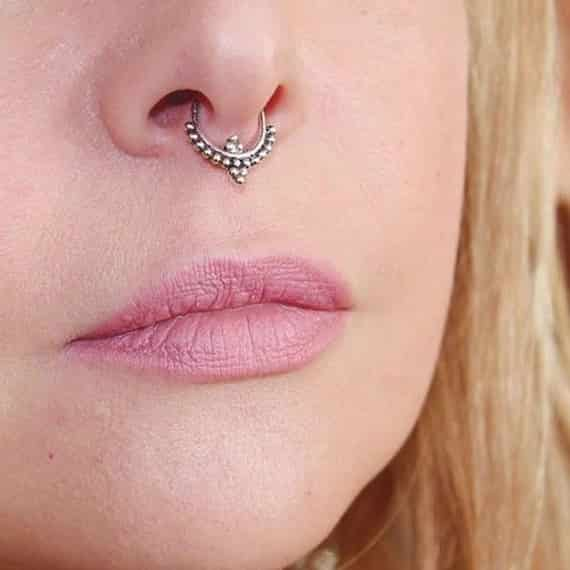
The History of Septum Piercings
Septum piercings have a long past. They go back to ancient times. Tribes in North and South America, Australia, and the Pacific Islands used them for religious, spiritual, and tribal reasons. Today, septum piercings are popular in alternative and mainstream fashion. They show individuality and non-conformity.
Busting Myths About Septum Piercing
There’s a lot of false information about septum piercings. Some people think that getting a septum piercing will cause severe pain or a deviated septum. But these are myths. A professional can perform the procedure with only mild discomfort. It won’t harm your nasal cartilage or breathing. Before you get a body modification, it’s important to know the facts.
How much does Septum Piercing Cost?
There are costs involved in getting a septum piercing. Several things can affect these costs.
What Affects the Price?
The price of a septum piercing can change depending on where you are, how experienced your piercer is, and the type of jewelry you choose. Piercers who are more reputable and experienced usually charge more. But they offer better safety and quality.
How Much Does it Usually Cost?
On average, septum piercings can cost anywhere from $40 to $100. This includes basic jewelry. Remember, when it comes to body modifications, don’t just go for the cheapest option. Safety and quality are more important than cost.
- Read here: Find Perfect Nose Piercing Placement

Step-by-Step Procedure of Septum Piercing
Undergoing a septum piercing involves a series of steps, each crucial to the overall safety and success of the process. A professional piercer carries out each of these steps with meticulous attention to detail.
1. Consultation
The journey to a septum piercing begins with a consultation. Your piercer will discuss the procedure, jewelry options, and aftercare, and answer any questions you might have. This is also when they assess your septum to ensure it’s suitable for piercing.
2. Cleaning and Marking
Once you and your piercer have agreed on the procedure, the piercer will clean your nostrils using a specialized solution to kill off any potential bacteria. The piercer will then use a skin marker to mark the exact spot where the needle will penetrate.
- Related: How to Clean a Septum Piercing
3. Clamping and Piercing
The piercer will then use a tool known as a receiving tube or a clamp to hold your septum in place. This helps to prevent movement during the piercing process. A professional piercer will aim for the “sweet spot” – a thin strip of skin in your septum, avoiding the cartilage. Using a sterile, hollow needle, the piercer will quickly push through this spot.
How to Find Your Sweet Spot
For a septum piercing, identifying the ‘sweet spot’ is crucial. This is the soft, flexible area found just before the firmer cartilage in the nostril’s base. To locate it, lightly pinch the end of your septum; you’ll feel a thin, pliable section of skin, typically nearer to the nose’s tip. Piercing this precise spot ensures minimal pain, faster healing, and reduced complications. An accurate identification by the piercer is vital, as piercing the cartilage can intensify pain and healing challenges
4. Inserting the Jewelry
Once the hole is made, the piercer will thread the initial jewelry through it. This jewelry is typically a small, thin piece that helps the piercing heal without irritation.
5. Aftercare Instructions
After the jewelry insertion, your piercer will provide you with aftercare instructions. They’ll guide you through the proper cleaning process and discuss potential signs of complications. Remember, following these aftercare instructions is crucial to ensure a smooth and infection-free healing process.
6. Check-ups
Your relationship with the piercer doesn’t end after you leave the shop. They’ll likely schedule follow-up appointments to check on the healing process and eventually change the initial jewelry if needed.
Septum Piercings Video Guide
Healing Process and Time Frame
After getting a septum piercing, the initial healing process typically takes about 6 to 8 weeks. Full healing, where your body completely recovers and the risk of infection is minimal, may take up to 6 months or more.
It’s worth noting that everyone’s body is unique. Your healing process might be shorter or longer depending on your health and how well you follow aftercare instructions.
Aftercare: Ensuring a Healthy Healing Process
When you get a septum piercing, the right aftercare routine is crucial for avoiding complications and ensuring a smooth healing journey. Here’s a structured plan to keep your septum piercing healthy and infection-free:
- Always start with clean hands before touching your piercing to prevent contamination.
- Clean the piercing using a saline solution twice daily to combat bacteria and support healing.
- Avoid unnecessary touching, twisting, or adjusting the piercing, especially during the initial weeks.
- Maintain a balanced diet, get adequate sleep, and stay hydrated to indirectly boost the piercing’s healing rate.
- Stay away from pools or hot tubs to reduce the risk of exposing your piercing to harmful bacteria.
- Be vigilant for signs of infection like unusual redness, swelling, or any unexpected discharge, and consult a healthcare professional if they arise.
By consistently following these steps, your septum piercing will heal optimally and remain infection-free.
How to Relieve Septum Piercing Pain and Address Infection:
Experiencing pain, itching, redness, and swelling after getting a septum piercing can be unsettling. These symptoms, especially when the pierced area feels hot to touch, often indicate an infection. While you don’t need to panic, timely intervention is essential for pain relief and healing. If you’ve adhered to your aftercare routine but still face discomfort, here’s what you can do:
- Maintain your cleansing routine with a saline solution 2-3 times daily. If symptoms persist, integrate a topical antibiotic ointment like bacitracin or mupirocin, ensuring you’ve checked for allergies.
- Apply a warm compress to the affected area for pain relief and improved blood circulation.
- Be alert to escalating symptoms. Infections can progress to complications like scarring, keloids, or bumps.
- If symptoms intensify or if you develop chills or a fever, it’s crucial to cease home remedies and consult a medical professional immediately.
Consistently following these steps can help you effectively manage septum-piercing pain and potential infections.
Septum Piercing vs Nostril Piercing:
Both septum and nostril piercings are types of nose piercings. But, they are different. Nostril piercings go through the soft part of the nostril’s outer area. Septum piercings go through the soft part inside the nose, the “sweet spot.”
Nostril piercings are often more visible, with studs or hoops used as jewelry. Septum piercings can look edgier with a wide variety of jewelry. You can also hide them with a septum retainer.
In terms of pain, many say that septum piercings have a strong but brief feeling due to the area’s sensitivity. Nostril piercings cause a quick, sharp sting. Both piercings have similar healing times, from six weeks to a few months.
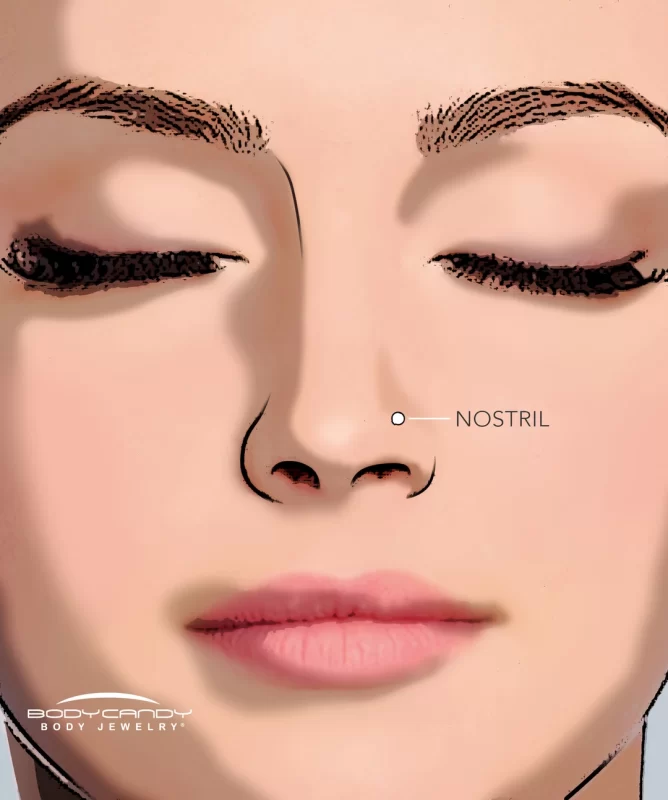
Pro Tip: If you’re unsure about getting a real septum piercing, try wearing a fake one for a few weeks first. This can help you decide if you like the look and feel before making a more permanent commitment.
Other Nose Piercing Types
- Nose Piercing
- Double Nose Piercing
- High Nostril Piercing
- Nasallang Piercing
- Mantis Piercing
- Austin Bar Piercing
- Rhino Piercing
- Nose Bridge Piercing
Septum Piercing Jewelry Material
The material of your septum piercing jewelry plays a critical role in the healing process and your comfort. Some commonly used materials include:
Surgical Stainless Steel:
This is the most popular choice due to its durability and hypoallergenic properties.
Titanium:
This metal is lightweight and hypoallergenic, making it a great option for people with sensitive skin.
Gold:
Gold, especially 14k or 18k, is a good choice, but avoid gold-plated jewelry as it can flake and irritate the piercing.
Glass:
Glass is hypoallergenic and safe for fresh piercings. It’s especially good for septum retainers.
Different Types of Septum Jewelry
When it comes to septum piercings, there are several types of jewelry you can choose from.
Captive Bead Rings
Captive bead rings (CBRs) are a common choice for septum piercings. They consist of a ring and a small bead that holds the ring closed. This design makes them easy to insert and remove. Plus, CBRs are available in a variety of colors and materials.
Horseshoe Rings
Horseshoe septum rings, also known as circular barbells, are shaped like a horseshoe and are another popular choice for septum jewelry. They have two removable beads, allowing for more customization. They’re comfortable and less likely to interfere with breathing or nose-blowing.
Septum Clickers
Septum clickers are hinged rings that ‘click’ into place. They are often more ornate, making them a great choice if you want to make a statement. They are easy to open and close, making them user-friendly. However, they tend to be pricier due to their intricate designs.
Septum Retainers
Septum retainers are ideal for those times when you need to hide your piercing. They can be flipped up into the nostrils, making the piercing virtually invisible.
Septum Tusks and Spikes
Septum tusks and spikes give an edgier look to your piercing. They are typically longer and pointed at the ends.
Seamless and Segment Rings
These rings offer a clean, continuous look as they have no beads or other attachments. The ring uses a single segment that can be removed for insertion and replaced once in place.
Septum Piercing Size
Knowing the correct size for your septum piercing jewelry is crucial for comfort and healing.
Here are the two main measurements you need:
Gauge:
This refers to the thickness of the jewelry that goes through your piercing. The standard gauge for septum piercings is usually 16G or 14G (the higher the number, the thinner the jewelry). Your piercer will typically decide the appropriate gauge for you based on your anatomy and the type of jewelry you want.
Diameter:
This is the inside width of the ring or circular jewelry. The most common diameter for septum rings is between 8mm to 10mm. However, this can vary based on personal preference and the size of your septum.
To measure an existing piece of jewelry, you can use a ruler, but for more precise measurements, a digital caliper is ideal. If you’re uncertain about your measurements, it’s best to consult a professional piercer. They can help you measure the size of your septum piercing and suggest the appropriate jewelry size.
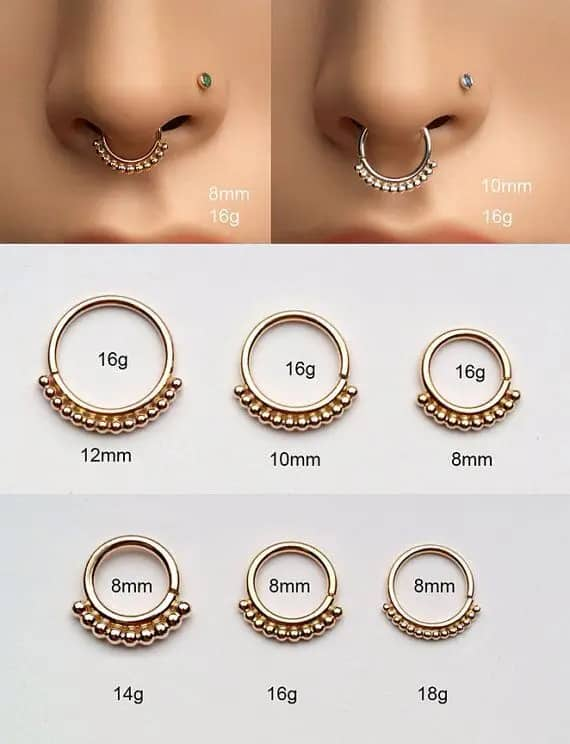
Variation and Styling Guide for Septum Piercings
A septum piercing can be styled in many different ways to suit your personality and aesthetic.
- Minimalist: A small, thin ring offers a subtle and delicate look.
- Edgy: Choose a tusk or spike for a bold and edgy vibe.
- Glamorous: Ornate septum clickers can make a glamorous statement.
- Alternative: Mix and match different jewelry styles or materials for an eclectic look.
- Invisible: Use a septum retainer when you want to keep your piercing hidden.
When Can I Change My Septum Piercing?
It’s usually best to wait until your septum piercing is fully healed before changing the jewelry. That’s typically around six to eight weeks. But complete healing may take up to six months. Changing the jewelry too early can irritate the piercing and make the healing take longer. Always ask a professional if you’re unsure.
How to Change Your Septum Piercing Jewelry for the First Time on Your Own:
Transitioning to a new look by changing your septum jewelry can be both exhilarating and nerve-wracking, especially if it’s your first time. You might prefer doing it yourself rather than seeking a professional piercer every time, and that’s entirely doable. Here’s your guide to swapping out that septum jewelry like an expert:
- Begin with immaculate hands: Washing your hands thoroughly is paramount.
- Sterilize your chosen new jewelry: Ensure it’s free from contaminants that might cause irritation or infection.
- Familiarize yourself with your jewelry’s mechanism: If it’s a barbell, remember the rule: “righty, tighty; lefty, loosey.” Carefully remove the ball or end of your existing piece.
- Gently and gradually thread in your new jewelry, making sure not to force or rush.
- Once securely in place, give the area a gentle cleanse with a saline solution to keep it clean.
- Revel in your refreshed look and brace yourself for a wave of compliments.
- Should any uncertainties arise, or if things don’t go as planned, don’t hesitate to consult a reputable piercer. It’s always better to be safe than sorry.
Armed with these steps and a steady hand, you’ll be a pro at changing your septum jewelry in no time.
Why Does My Septum Piercing Smell?
The smell, often like a “cheesy” odor, comes from a buildup of dead skin cells and natural oils around your piercing. This is known as “piercing funk” and is completely normal. Regular cleaning with a saline solution can help reduce the smell. If the smell comes with other symptoms like pain, redness, or swelling, it might be an infection, and you should ask a professional.
What Does a Septum Piercing Mean Sexually?
Some people believe body piercings, including septum piercings, can show a person’s sexual preferences or tendencies. But, body modifications are mostly a form of self-expression and personal choice. A septum piercing, like any other body modification, doesn’t inherently show anything about a person’s sexual orientation or preferences. Instead, it should be seen as a way for people to show their personal style and individuality.
Does Getting a Septum Piercing Hurt?
How much a septum piercing hurts is different for everyone. Everyone has their own pain threshold. However, most people describe it as a quick, sharp pinch followed by a dull ache. The pain usually goes away quickly and is easy to manage. If the pain continues after the procedure, it’s a good idea to talk to your piercer or a healthcare provider.
What Is a Fake Septum Piercing?
A fake septum piercing is a type of jewelry. It looks like a real septum piercing, but you don’t need a real piercing to wear it. It’s a ring or bar that clips onto the septum.
Fake septum piercings are great for people who like the look of a septum ring but aren’t ready for a real piercing. You can put them on and take them off whenever you want. They come in many designs and materials. You can find simple ones made of steel or fancy ones made of gold with gems. This means you can change your style whenever you want.
Possible Risks and Problems
Septum piercings are usually safe, but there are possible risks. If you don’t take care of it properly or if the piercing is done badly, you can have problems. You could get an infection, or your body could reject the jewelry. You might even develop keloid scarring. Before you get a piercing, talk about these risks with your professional piercer. After the piercing, follow their care instructions carefully.
Celebrities Sporting Septum Piercings
Septum piercings have long been in the limelight, thanks to many celebrities who proudly sport them. Celebrities like Gigi Hadid, Rihanna, Zoë Kravitz, FKA Twigs, and Lady Gaga have all been spotted with septum piercings. Their bold choice of jewelry adds to their unique personal style, inspiring fans and fashionistas alike.


Septum Piercing Detailed Information Table
| Key Takeaways | Details |
|---|---|
| Origin | Septum piercings are an ancient body modification |
| Popularity | Popularized in modern culture, often sported by celebrities |
| Misconceptions | Various myths surround septum piercings, many of which can be debunked |
| Potential Risks | Exist but can be mitigated with professional handling and good aftercare |
| Pain Level | Varies from person to person, generally bearable |
| Cost Factors | Depends on location, piercer’s experience, and chosen jewelry |
| Jewelry Variety | Numerous styles and types to express individual personality |
| Importance of Aftercare | Ensures a healthy healing process and prevents complications |
FAQs
How painful are septum piercings?
The pain from a septum piercing is usually brief and intense due to the sensitivity of the area. However, the pain level varies from person to person. For some, it might feel like a quick pinch or a sharp sting, while others might feel their eyes water. Most people agree that the anticipation of the pain is often worse than the actual piercing.
Is a septum piercing extremely painful?
Most people do not find septum piercings extremely painful. Yes, they can be uncomfortable for a moment. But, pain varies from person to person. Many professional piercers have techniques to keep you comfortable during the process. It helps to breathe and stay calm.
What does a septum piercing mean on a woman?
A septum piercing on a woman, or anyone else, doesn’t hold a particular meaning. It’s often a personal expression of style. Body modifications like septum piercings are a personal choice. They do not necessarily say anything about a person’s identity or beliefs.
Do septum piercings fall out easily?
Septum piercings should not fall out if the jewelry is secure. However, if the jewelry is loose or doesn’t fit well, it could fall out. If your jewelry is falling out or not fitting right, consult with a professional piercer.
What is the most painful piercing?
Pain levels for piercings can differ greatly. They depend on the person’s pain tolerance and where the piercing is. Generally, piercings that go through hard cartilage, like daith or industrial piercings, hurt more than soft tissue piercings like the earlobe or septum.
Conclusion
Getting a septum piercing is a unique way to express your personal style. Like any piercing, it requires thoughtful consideration, professional execution, and diligent aftercare. Remember to choose a professional piercer, follow the aftercare instructions carefully, and enjoy your new piercing safely. Whether you go for a minimalist look or a bold statement piece, your septum piercing is sure to add a distinctive touch to your style.
Further Reading for Piercing Enthusiasts:
- How To Reopen A Closed Nose Piercing
- Which Side of My Nose Should I Pierce
- Nose Piercing Gauge
- Nose Ring According to Face Shape

Camila Luna is a passionate jewelry enthusiast and content creator at Miami Jewelry Co. With a focus on providing high-quality, Miami-style jewelry, Camila and her team specialize in a wide range of jewelry that includes bracelets, necklaces, earrings, and more
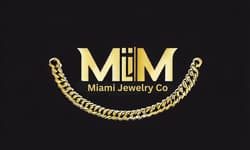

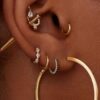

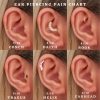
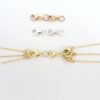
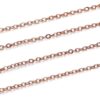
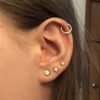


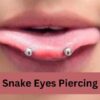


Your writing skills are amazing! I really love it!